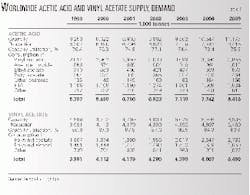World consumption of acetic acid will increase 2.9%/year on average between 1999 and 2009.
That growth will be driven by expansion in production capacity of vinyl acetate, which accounted for 44.6% of total acetic acid consumption in 1999. During 1999-2009, consumption for this purpose will grow by 3.2%/year average, according to a study by Tecnon Ltd., London.
"The US continues as the powerhouse of acetic acid and vinyl acetate production with major plants and beneficial material costsellipse.The most exciting developing regions around the world continue to be East Asia [and] South and Southeast Asia. Consumption, capacity, and production for both acetic acid and vinyl acetate will grow strongly in these regions," Tecnon's report stated.
Acetic acid
The Tecnon study shows that, in 1999, total world acetic acid capacity was 8.3 million tonnes/year. Production (or consumption) was 6.3 million tonnes.
In 1999, North America maintained the largest acetic acid capacity-35.6% of the worldwide total. Western Europe was second with 21.1%, followed by East Asia with 19.6%. All regions except for South America, Western Europe, and Japan showed an increase in capacity, Tecnon's report noted. By 2009, North America will retain the largest share of world capacity at 33.0%, followed by East Asia with 19.2% and Western Europe with 14.4%.
In 1999, North America led world production of acetic acid with 37.6%. Western Europe produced 22.4% of world production, and East Asia produced 18.4%.
By 2009, North America's share of world production will slip 37.3%. Western Europe's share will fall to 15.8%, and East Asia's share will increase to 22.6% (Fig. 1), noted Tecnon's report.
Utilization of world acetic acid capacity in 1999 was 76.4%; by 2001, it will drop to 74.8%. Thereafter, Tecnon predicts, utilization will increase to 77.1% in 2002, followed by a further dip to 70.5% in 2005 and a slight increase to 73.4% in 2006 (Table 2).
North America led world acetic acid consumption with 33.0% in 1999, followed by East Asia with 28.0%, Western Europe with 20.7%, and Japan with 12.0%.
"There will be a very rapid rate of growth of acetic acid consumption in some of the regions where current levels are low," the Tecnon study noted. "Very significantly, because the actual volumes become substantial, South and Southeast Asian consumption will grow by an average 6.6%/year in the period 1999-2009.
"Average growth in acetic acid consumption in North America, Western Europe, and Japan will be low in the period 1999-2009 at 2.1, 1.6, and 0.7% per annum average, respectively. Perhaps the most exciting region is East Asia, which has a high consumption and a high rate of growth-4.1% per annum average from 1999-2009."
Vinyl acetate
Total world vinyl acetate capacity in 1999 was 4.6 million tonnes, according to Tecnon. Production was 4.0 million tonnes.
During 1999-2009, world production of vinyl acetate will grow by 3.2%/year on average; capacity will grow by 3.5%/year on average. In 1999, North America had the largest vinyl acetate capacity-38.6% of the worldwide total. East Asia was second with 18.2%, Western Europe third with 16.2%, and Japan followed with 12.8%.
In 1999, North America led world production of vinyl acetate with 30.9%, followed by East Asia with 21.3%, Western Europe with 21.1%, and Japan with 14.1%.
By 2009, North America and Western Europe's share of world production will decrease to 30.3% and 18.4%, respectively. East Asia's share will increase to 22.6%, noted Tecnon's report.
Utilization of world vinyl acetate capacity in 1999 was 86.8%. By 2001, it will increase to 87.8%. Thereafter, it will decrease to 80.7% in 2005, followed by a modest slide to 79.0% in 2007, and an increase to 83.9% in 2009.
North America led world vinyl acetate consumption in 1999 with 30.9%. East Asia was second with 21.3%, followed by Western Europe with 21.1%, and Japan with 14.1%. Tecnon predicts that consumption in South and Southeast Asia will increase rapidly-by an average 9.3%/year. In contrast, growth in Western Europe and Japan will be particularly low at 1.8% and 1.5%, respectively.
Polyvinyl acetate production is the major end use of vinyl acetate, accounting for 45.3% of total consumption in 1999. Consumption of vinyl acetate for this end use will grow by an average 4.4%/year during 1999-2009.
Competition in the acetyls business is becoming more vigorous, as existing major players struggle for advantage and new rivals seek to join the league. The long-term winners in this business will be those with the best technology position, the report concluded.



